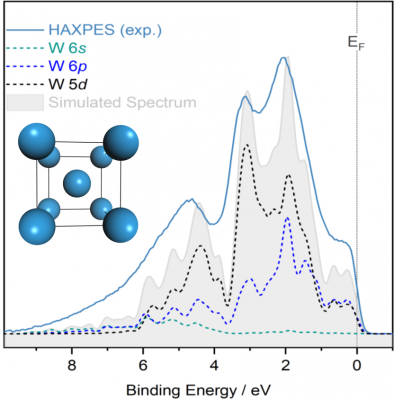
Tungsten is one of the reference plasma-facing materials in fusion power devices due to its excellent temperature resistance and low tritium retention. The investigation of the electronic structure is key for implementing tungsten-based technologies as it is strongly related to the stability and properties of the material. However, despite the large efforts in studying the electronic properties of tungsten metal, some complex features are still not properly characterised.
The combination of state-of-the-art experimental and theoretical approaches is key to describing the electronic structure of tungsten, as presented in a recent publication in Physical Review B, entitled “Lifetime effects and satellites in the photoelectron spectrum of tungsten metal“.
This work has been led by Curran Kalha and Anna Regoutz, from the Applied X-ray Spectroscopy (AXS) group at University College London, who characterised the tungsten spectrum using a combination of high-resolution soft and hard X-ray photoelectron spectroscopy (SXPS and HAXPES) with reflection electron energy loss spectroscopy (REELS).
Experimental measurements are complemented with ab-initio calculations, which support the interpretation of the complex tungsten spectra. In particular, Linear-Scaling Density Functional Theory (LS-DFT) calculations have been used to calculate tungsten’s projected density of states (PDOS) using the BigDFT code. LS-DFT can model atomic systems with thousands of atoms with high accuracy and reproducibility, overcoming the computational cost limitations of traditional cubic-scaling DFT. These results are compared with the experimental measurements at the valence band and settle the base for describing disordered and defective tungsten systems in future studies. LS-BigDFT calculations have been carried out by the BSC researchers Julio Gutiérrez Moreno, Stephan Mohr and Mervi Mantsinen, in close collaboration with the BigDFT developer Laura Ratcliff (Imperial College London).
The exhaustive analysis of SXPS and HAXPES core-level spectra in this work provides new insights into the nature of specific transitions underlying the observed satellite features. Spectral functions calculated from Many-Body Perturbation Theory (MBPT) within the GW, and “GW plus cumulant” (GW+C) approaches have been used to support the experimental assignments. These calculations have been carried out by Johaness Lischner’s team at Imperial College London.
The results and methodology detailed in this paper provide key insights for fundamental and industrial applications of tungsten and will be of use for the future exploration of other materials with complex electronic structures.
Sources:
- The article can be accessed from Physical Review B: https://journals.aps.org/prb/abstract/10.1103/PhysRevB.105.045129
- The initial preprint version can be downloaded from arXiv:2109.04761v1
- All survey, core level and valence band spectra from SXPS and HAXPES are freely available at: https://doi.org/10.6084/m9.figshare.16432617
- Datasets from LS-BigDFT calculations are also openly accessible at the NOMAD repository: https://dx.doi.org/10.17172/NOMAD/2021.08.27-1
We acknowledge the access to computational resources and technical support at MareNostrum provided by BSC (RES-QS-2020-3-0026) and the EU-JA Broader Approach collaboration in the Computational Simulation Centre of International Fusion Energy Research Centre (IFERC-CSC). This work was financially supported by the FusionCAT project with reference number 001-P-001722, co-financed by the European Union Regional Development Fund within the framework of the ERDF Operational Program of Catalonia 2014-2020, with the support of Generalitat of Catalonia.
![]()
![]()
![]()
